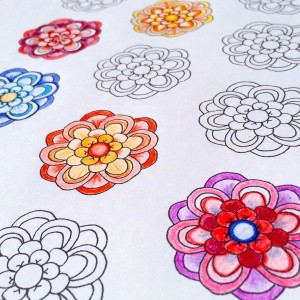I hope you have enjoyed Part 1 and Part 2 of this series of blog posts on ‘How to Color In’.
This third post is the first one to discuss specific coloring techniques, and we’re starting with the most basic coloring in technique – shading.
What is shading?
Pencil shading involves moving a pencil back and forth on paper to fill in an area of a coloring page.
Increasing downward pressure results in darker or more intense color, while lighter pencil pressure gives a softer and lighter effect.
Some colorists use just the tip of the pencil, while others tilt the pencil at an angle so that the side length of the pencil lead is in contact with the paper, and not just the tip. Because more of the pencil lead is in contact with the paper at once, this allows the colorist to shade in a larger area in a shorter period of time.
Crayons may also be used for shading, but not standard markers (though some special blender markers produce a ‘shade’ effect that creates graduations of color with markers).
Types of shading
Flat shading
Flat shading is required if you want to color an area and have it all look even. If you want to produce a consistent shade, keep an even pressure on the pencil while coloring in. The better you can control and maintain the same pressure on your pencil, the smoother and more consistent your result will be.
Graduated shading
Graduated shading means going from dark to light (heavier pressure to lighter pressure on the pencil) or light to dark (lighter pressure to heavier pressure on the pencil). Graduated shading gives a contour effect to colored in objects, making them look more three-dimensional.
Blending colors shading
Many colorists are confused about how to use shading to smoothly move from one color to another across an image. For example, they may be coloring in a picture of a skirt, which they want to be blue from the waist down, but purple from the knees up, blending halfway between to make a perfect wash of color that smoothly transitions from blue to purple in the middle.
The simplest way to do this two-color blended shading, is to use graduated shading in opposite directions. In the example above, you would use blue pencil first, shading from dark at the waist to light just above the knees. Then you would use a purple pencil, shading from dark at the bottom of the skirt and getting lighter until you had almost reached the waist. Halfway between the two colors you should have a 50/50 mix of blue and purple. When blending shading is done well, one color should seamlessly fade in to the next. This takes practice, but can be perfected in a surprisingly short period of time if you work slowly and carefully.
My best shading tips
They key to shading for beginners is to work slowly. Quick shading generally produces an uneven texture with too much pressure in places (which means you have to go back over the lighter sections to even it up, and if you go too far then you need to darken up other parts, and it gets heavy-handed pretty quickly).
Use a light touch and build up your color gradually. Start with smaller areas – it’s much easier to be consistent across a small area than a big one.
Try to go all the way from one side of the outline of the area you’re coloring in, to the other side of the outline, with each stroke of the pencil. Shade so that your pencil is travelling the shortest width with each stroke instead of the longest for the most even result.
